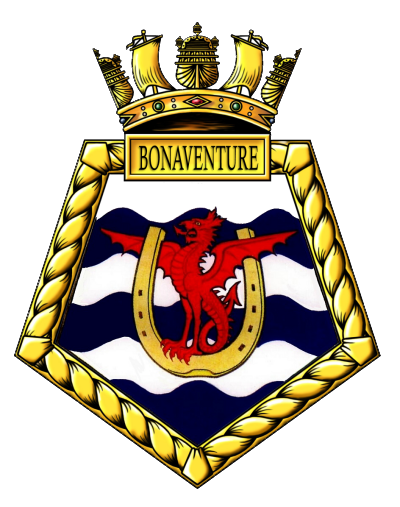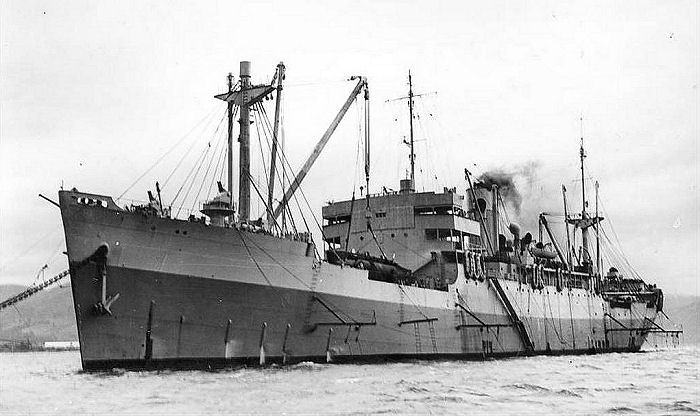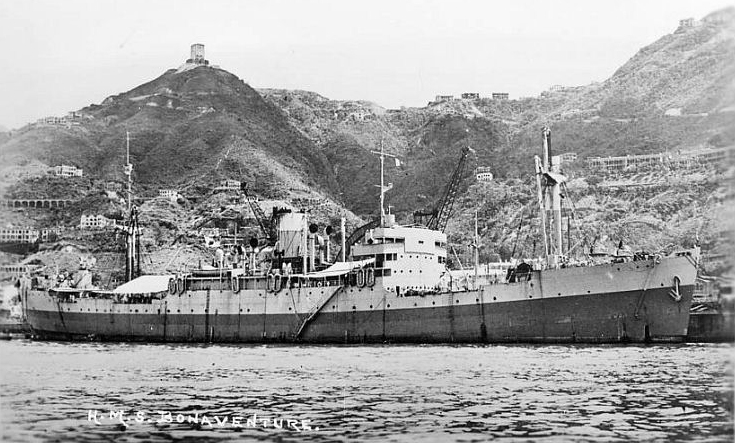Submarine Depot Ship

Battle Honours
LOWESTOFT 1665
FOUR DAYS' BATTLE 1666
ORFORDNESS 1666
SOLEBAY 1672
SCHOONEVELDT 1673
TEXEL 1673
BEACHY HEAD 1690
BARFLEUR 1693
CHINA 1900
Specifications
Builder:Greenock Dockyard Co Greenock, Scotland, United Kingdom
Displacement: 8,067 tons
Length: 487 ft
Beam: 63 ft
Draught: 30 ft
Speed: 16 Knots
Crew complement: 242
Commanding Officers
Cdr. William Eric Banks, DSC, RN 8 Nov 1942
A/Capt. Philip Quellyn Roberts, RN 16 Apr 1943
Cdr. (ret) William Richmond Fell, DSC, OBE, RN 18 Jan 1944 to Nov 1946
Related items
None
Reminiscences
None
Gallery
None
H.M.S. BONAVENTURE

Early history
Built by Greenock Dockyard Co., Greenock as the merchant cargo ship CLAN DAVIDSON for the Clan Line. She was acquired by the Admiralty while still under construction for completion as a Depot Ship. She was launched on October 27, 1942, and was converted at the yards of Scotts Shipbuilding and Engineering Company; on completion was commissioned as HMS BONAVENTURE on January 23, 1943 as a depot ship for X-craft midget submarines under the command of Captain William "Willie" Banks.
After completing her sea trials and work-up BONAVENTURE sailed to Loch Striven on the Clyde to become the main training base and depot ship for the X craft midget submarines. In April Captain P.Q. Roberts, RN assumed command, Captain Banks being appointed to command the shore base HMS VARBEL at Port Bannatyne. During August 1943 training and trials were carried out using the midget submarines in preparation for Operation SOURCE, an attack on the German battleship Tirpitz in Altenfjord, Norway which in September.
In October, BONAVENTURE began a refit at the yards of Alexander Stephen and Sons, Govan. The refit which involved the fitting of new radar equipment was halted on January 2nd, 1944 leaving some work uncompleted; the ship recommissioned on January 22nd Captain William Fell RN taking over as commanding officer. She again deployed at Loch Striven but remained operational for only a short time training crews for an attack on the enemy held Laksevåg f floating dock at Bergen, Norway, planned for April, before returning to Govan to complete the outstanding refit work during March; she was to remain in dockyard hands until August, returning to Loch Striven again after completing post-refit trials. The first Bergen attack was successful and the operation was repeated during September 1944, this was to be HMS BONAVENTURE's last involvement with operations in home waters, being re-tasked with training the newly arrived XE class midget submarines, a modified version of the X class which had been under construction since January 1944.
During her last refit the Admiralty had decided to reallocate the BONAVENTURE, equipped with a complement of six XE boats, for operations with the proposed British Pacific Fleet. In December she was nominated for deployment as the depot ship for the 14th Submarine Flotilla in the south west Pac and left the UK on February 21st, 1945 bound for Australia via the Panama Canal and Pearl Harbour.
Reallocated to the British Pacific Fleet
When she arrived at Honolulu on March 7th Captain Fell reported to Admiral King who had no employment for midget submarines so the ship was despatched to Brisbane where she arrived on April 27th, to discover that there was no planned role for her to fulfil. In early May she sailed to Townsville, Queensland, and Captain Fell flew to Subic Bay in the Philippines to call on Rear Admiral James Fife US Navy, the Commander Submarines, Southwest Pacific, in the hope of finding a role for his flotilla; the meeting was not productive - the US Navy saw no use for midget submarines and dismissed them as 'unorthodox British weapons.'
The ship's future was now uncertain, it was suggested that she was a candidate for conversion for Fleet Train duties, and the midget submarines should be scrapped. Her lock was to change however on May 31st, when while attending a staff conference in Sydney, Captain Fell was asked whether his midget submarines could cut submarine telegraph cables. Since the Japanese radio transmission codes had been broken the only secure messages were those sent via the submarine telegraph cables which connected several points in South-east Asia to Japan these were now considered priority targets.
With a sanctioned mission profile HMS BONAVENTURE was moved 250 miles north of Brisbane to Hervey Bay, Queensland, in early June to begin extensive training and experimentation in an area south of Townsville, to prepare for the cable cutting operations. A disused telegraph cable between Australia and New Guinea was used as a training aid but the task proved to be quite hazardous, claiming the lives of two divers who died after suffering oxygen poisoning. The 14th Submarine flotilla was ready in July and Captain Fell presented his operational plans to Admiral Fife, it was then revealed that further targets, of the sort the crews had originally trained for, were in the offing: the two Japanese heavy cruisers, Myōkō and Takao, at Singapore.
BONAVENTURE sailed for Victoria Harbour, Labuan, Borneo once the operational targets had been selected, flying the flag of Admiral Fife who joined her for the duration of the three operations: Operation STRUGGLE - attack Japanese cruisers Myōkō and Takao, within Singapore harbour; Operation FOIL - aimed to cut telegraph cables in the Lamma Channel, off Hong Kong; Operation SABRE - was intended to cut telegraph cables at Cap St Jacques, off Saigon.
The operations began on July 26th, 1945, when HMS STYGIAN towed XE3 and HMS SPARK towed XE1 to their target area for Operation STRUGGLE. XE3 was tasked with mining the cruiser Takao, XE1 the Myōkō. The approach through the Straits of Johor and harbour defences took 11 hours, once inside they had to locate the camouflaged target vessels and avoid detection by Japanese defenders; XE3 successfully reached the Takao, affixed her limpet mines and dropped the 2-ton side charge beside the hull. XE3 safely withdrew and contacted her escort HMS STYGIAN. XE1 had been dogged by harbour patrols and could not make up enough time to reach the cruiser Myōkō so which was 2 miles further in than the Takao, instead her commander decided to add their charges to those of XE3 before withdrawing to rendezvous with HMS SPARK. The resulting explosions left the Takao badly damaged and settled onto the seabed, she never sailed again. The two midget subs were towed back to the BONAVENTURE, XE3 arriving alongside on August 4th and the delayed XE1 on the following day. This was the only offensive operation conducted by midget submarines in the Pacific theatre; the success of the raid earned two members of the crew of XE3 the Victoria Cross.
Operation SABRE involved HMS SPEARHEAD towing XE4 to a point 40 miles off the Mekong Delta where the two telephone cables lay on the sea bed; the tow was slipped on the evening of July 30th. XE4 used a towed grapnel to locate the cables; both cables were located and successfully cut by her two divers the following day. Normally XE craft carried one diver but the cable cutting missions meant that crews faced a work load that necessitated a second diver being carried. XE4 and SPEARHEAD arrived back at the BONAVENTURE on August 3rd, where her crew produced 'gift wrapped' sections of the two cables.
&Operation FOIL was launched from the Philippines with HMS MAIDSTONE, based at Subic Bay, acting as the depot ship; on July 27th XE5 set out under tow from HMS SELENE to reach the target off Lamma Island, Hong Kong. This was to prove the trickiest of the three missions; it was to take three and a half days of searching in thick mud before they succeeded in locating the telephone cable. Conditions for the divers were poor and an injury while attempting to use the cable cutter forced the sub to withdraw without being able to confirm the success or failure of the mission. She was taken in tow by SELENE on August 4th, both returning to Subic Bay on the 6th. It was only after the liberation of Hong Kong that it was revealed that they had been successful.
A repeat of Operation STRUGGLE was planned to finish the job but was cancelled just prior to departure, the towing lines where ready for connection when the operation was scrapped. Her operations complete BONAVENTURE sailed for Subic Bay to deliver Admiral Fife and recover XE5, before returning to Borneo. After the Japanese surrender she was ordered back to Sydney, sailing from Labuan on August 20th. On her arrival at Sydney the 14th Submarine Flotilla was paid off and the BONAVENTURE was prepared for a new task, one that was facing many vessels of the BPF, that of redeploying materials and repatriating displaced persons and internees. Her midget subs were put ashore and all related stores and maintenance equipment was removed to prepare her for operations as a heavy transport.

Post War history
Once ready the BONAVENTURE set off on the first of several voyages to Hong Kong, Japan, China, Malaya and the Philippines delivering and collecting passengers and stores which included transporting VAD (Voluntary Aid Detachment) personnel to man a hospital l at Hong Kong, a company of Ghurkhas ferried from Singapore to Kure in Japan, and a troop of ENSA entertainers bound for Hong Kong. She steamed over 60,000 miles before being released for return to the UK to decommission. She was involved in the rescue of 85 survivors and a dog from the frigate HMS AIRE which had run aground on the notorious Bombay Reef, just off the main Hong Kong to Singapore shipping lanes on Christmas Eve 1946 while returning home for decommissioning to the reserve fleet and eventually put up for disposal. She was placed on the disposal list in 1948, and sold back to the Clan Line on 23 March 1948. She was converted back to mercantile use, and entered service as the S.S Clan Davidson. She was the first Clan Line vessel to re-enter service after the end of the war. She was sold for scrap in 1963 and arrived at Hong Kong for breaking on 25 December 1963.
Last modified: 23 February 2023
Primary information sources
Additional sources:
Comments (3)
A few more of his photos
My dad James Leach served on the Bonaventure during WW2.
Anyway of locating the list of service men on this vessel. My father served on HMS Bonaventure.